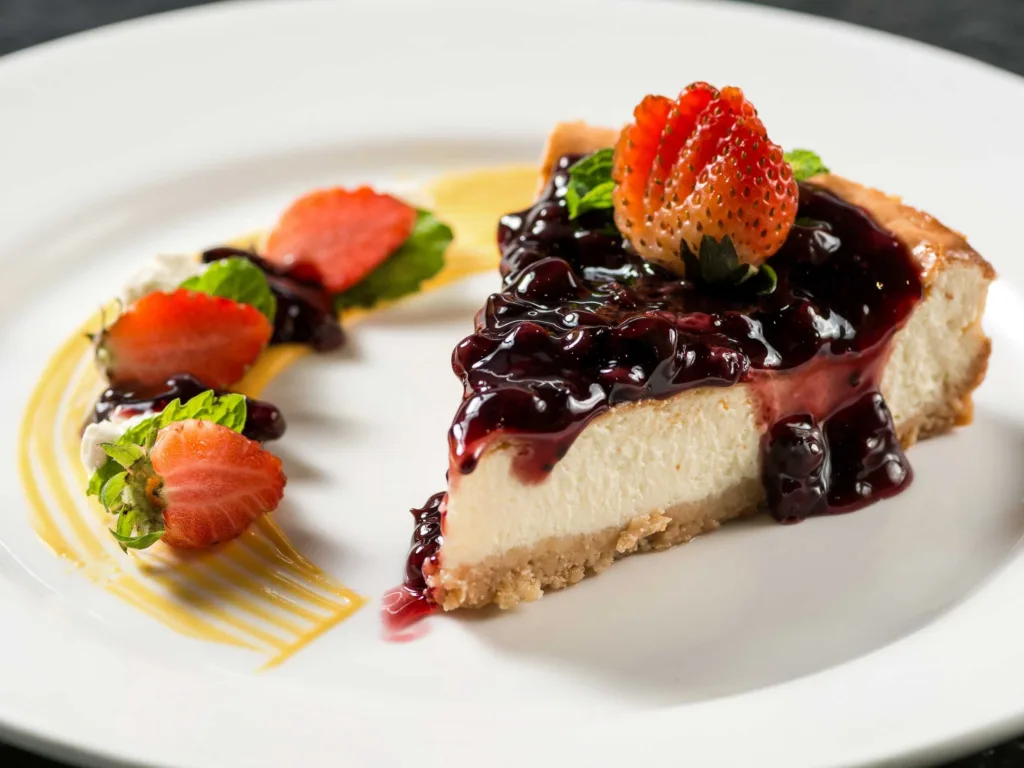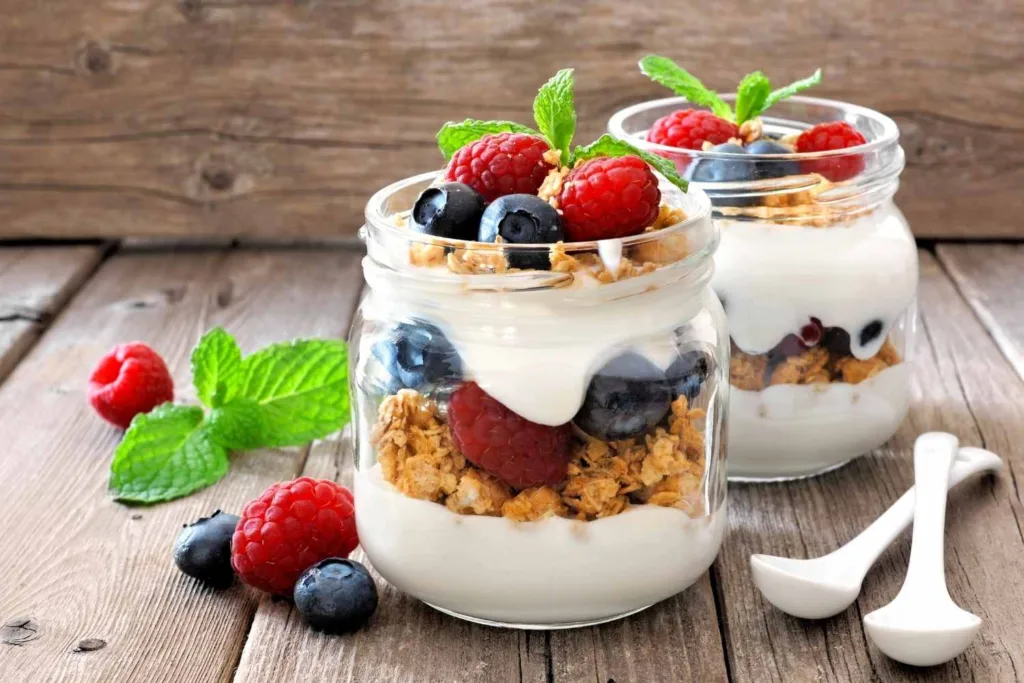“You can’t buy happiness, but you can buy dessert. And that’s kind of the same thing.” This popular saying reflects our collective love affair with sweets and treats. For many pursuing weight loss, the mere thought of dessert conjures up feelings of guilt. After all, conventional wisdom states that if you want to lose weight, you must say no to anything sweet.
However, emerging research reveals that enjoying dessert in moderation may not be antithetical to shedding pounds. This article will explore how reimagining desserts, selecting wholesome ingredients, practicing mindful eating, and employing sweeteners and substitutes judiciously could make room for sweet surprises on your journey to a healthier you.

I. Introduction
“Let’s face it, a nice creamy chocolate cake does a lot for a lot of people; it does for me.” – Audrey Hepburn succinctly captured our abiding weakness for decadent desserts. For those seeking to lose weight, the temptation posed by sweets often feels like the enemy. But must dessert be forever banished when dieting? Not necessarily.
With mindful choices, portion control, and quality ingredients, desserts can potentially be part of a balanced approach to weight management. This article will uncover how the pleasure of occasional desserts may support, rather than sabotage weight loss efforts. We’ll explore smarter selections, provide healthy recipes, and offer tips on integrating sweet treats while shedding pounds. Get ready for a fresh perspective on desserts!
II. Reimagining Desserts
You know the feeling. It’s late afternoon and you’ve powered through the day fueled by your healthy breakfast and nutritious lunch. Suddenly that mid-afternoon slump hits and your thoughts drift dreamily towards donuts, brownies, cookies or cake. The hunger for something sweet is real and difficult to override.
This yearning stems from deeply ingrained preferences and our brain’s chemistry. Researchers propose that we’re hardwired to respond to sugar’s taste with feelings of pleasure and reward. Simple carbohydrates like sugar lead to release of serotonin, a “happy” brain chemical. We often crave sweets when stressed, sad or bored due to serotonin’s calming effects.
Evolutionary factors are also at play. For early humans, sugary foods provided quick energy critical to survival. While we no longer forage for survival, our biology still screams for sugar. Understanding these psychological and physiological triggers makes it easier to reframe our relationship with sweets.
The key is balancing indulgence with nutrition. For instance, replacing a daily milk chocolate bar with a weekly shared dessert of baked apple with oats and cinnamon provides comfort along with protein, fiber and nutrients. Through thoughtful choices, we can gradually retrain our sugar-loving brains.
III. The Power of Ingredients
When it comes to desserts, ingredients matter. Opting for nourishing foods over refined sugars and unhealthy fats can transform standard treats into healthier alternatives. Fruits infuse desserts with vitamins, minerals, fiber and antioxidants. Bananas, apples, avocados, dates and berries add sweetness, moisture and body to baked goods. Swapping butter for avocado or apple sauce in brownies yields similar decadence with better nutrition.
Nuts like walnuts and almonds boost protein and healthy fats while offering crunch. Whole grains like oats, quinoa and amaranth provide fiber and key nutrients missing from simple sugars. Spices take desserts up a notch by providing concentrated flavor without added calories. Cinnamon, nutmeg, ginger, allspice and vanilla extract all allow you to use less sugar. When shopping, choose unprocessed ingredients or minimally processed whole foods as the starting point for desserts. Build treats around wholesome offerings from nature and achieve balance through smart substitutions.

IV. Mindful Eating
Mindfulness practices which increase awareness and attentiveness can be applied to make dessert consumption more conscious. Slowing down to appreciate each rich flavor and texture counteracts the tendency to eat desserts hastily. Before taking that first bite of cake, take a moment to notice the sensation of anticipation. Allow yourself to take small, deliberate bites and set any devices down to minimize distraction.
While enjoying dessert, tune in to signals like sweetness, creaminess and aroma. Avoid eating directly out of a carton or package, and plating dessert to enjoy seated at a table encourages mindfulness. Pause halfway through the serving and check in about fullness before continuing. End the dessert experience with gratitude for the pleasurable moments and nutrition gained. Applying mindfulness techniques transforms dessert from an individual act into a self-care ritual centered on awareness.
V. Sweeteners and Substitutes
When preparing desserts, sugar alternatives provide options for reducing calories without forgoing sweetness. Blackstrap molasses offers trace minerals along with a rich, syrupy sweetness. Date paste made by blending pitted Medjool dates can mimic sugar’s binding properties in baked goods. Stevia extracts derive natural sweetness from the Stevia leaf without spiking blood sugar.
Grade B maple syrup brings a hint of earthiness while costing fewer calories than refined sugar. Unsweetened applesauce is suitable for baking, lending moisture and mild sweetness. For those sensitive to aftertaste, erythritol is a zero-calorie sweetener fermented from corn that approximates sugar’s taste.
While these alternatives assist with calorie control, some nutritionists suggest limiting portion sizes due to concerns regarding effects on gut health and diabetes risk. As with any diet change, moderation, variety and careful tracking of results helps determine the right fit.
VI. Delicious Dessert Recipes
The following nutritious and delicious desserts prove you can enjoy sweetness and uncompromising nutrition on your weight loss journey.
PB & J Breakfast Cookies – These protein-packed cookies supply the power you need to start your day strong. Three cookies provide 140 calories, 5g protein and 3g fiber.
Ingredients: Rolled oats, almond butter, ground flaxseed, egg whites, vanilla extract, baking powder, unsweetened applesauce, strawberries.
Mango Avocado Pudding – Creamy and refreshing, this pudding is the perfect light dessert or afternoon snack. 1/2 cup offers 120 calories and 3g fiber.
Ingredients: Mashed avocado, mango, plain Greek yogurt, honey, lemon juice, sliced almonds.
Chia Seed Berry Parfait – Layer chia pudding with mixed berries for a fiber and antioxidant-rich treat. 1 parfait provides 250 calories, 10g fiber and 25% Daily Value for vitamin C.
Ingredients: Chia seeds, unsweetened almond milk, vanilla extract, blueberries, strawberries, blackberries.
Zucchini Walnut Brownies – Fudgy, nutty brownies punctuated with bursts of chocolate chips taste indulgent but provide wholesome energy. 1 brownie contains 110 calories, 2g fiber and 5g protein.
Ingredients: Grated zucchini, whole wheat flour, eggs, applesauce, cocoa powder, chocolate chips, walnuts.

VII. Dessert and Balanced Nutrition
Through careful macronutrient planning, dessert can be one component of a nutritionally balanced diet supporting weight management. Protein and fiber keep you feeling full; healthy fats aid hormone balance; complex carbs deliver sustained energy. These pillars should make up snacks and meals leading to dessert. Portion dessert as 15% of your total daily calories – a thumb-sized slice of cake or half-cup serving of ice cream fits the bill. Pair dessert with fruit or nuts to add nutrients. Finally, think weekly, not daily treats. Having dessert 2-3 times maximum will satisfy cravings without overkill. An 80:20 approach – eating healthy 80% of the time and allowing treats 20% – establishes the flexibility and balance required for long term weight loss.
VIII. Staying on Track
Here are some pro tips to stay committed to your healthy dessert philosophy while navigating real world temptations:
Special Occasions – Don’t go it alone. Ask a health conscious friend to enjoy a dessert tasting plate so you can try lots of flavors while controlling portions.
Office Treats – Bring your own baked goods made with quality ingredients to share so you have a healthy option.
Restaurants – Inquire if they’ll split a dessert; most will. Select sorbet or fresh fruit if available.
Emotional Eating – Forewarned is forearmed. Know your triggers and have a backup plan, like a gentle walk or calling a friend.
Parties & Holidays – Focus on catching up with loved ones. Eat slowly and gauge fullness often. Sip sparkling water between bites to cleanse your palate.
Traveling – Research healthy dessert spots in any new destination. Indulge thoughtfully then counterbalance with active excursions or lighter fare.
When dessert becomes a conscious choice rather than compulsion, moderation comes naturally.

IX. Conclusion
The path to improved wellbeing need not be devoid of sweets. With intention and intuition, desserts can punctuate healthy nutrition. Begin by examining motivations and crafting thoughtful alternatives. Reimagine dessert ingredients by spotlighting wholesome offerings from nature. Employ mindful eating to recalibrate your relationship with food. Explore sugar substitutes and less processed sweeteners. Dessert becomes a celebration of both sustenance and self care when approached with reverence. Allow yourself grace through the process. Each small step towards balance lays the groundwork for lasting lifestyle change. The journey to wellbeing is sweetened when we see dessert as an opportunity for joy and empowerment.
X. Call to Action
If you enjoyed these tips and want to receive more recipes, food insights and weight loss motivation, be sure to subscribe to my free Healthy Living newsletter! Subscribers gain access to bi-weekly expert guidance on nutrition, mindful eating, fitness and overall wellness. I’ll provide regular content updates to support you on your journey towards optimal health. Thanks for reading and please reach out with any comments or questions!
Thank you for reading this post, don't forget to subscribe to our free newsletter
!
